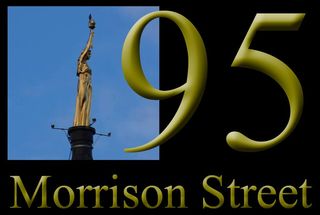Co-operative House and the statue of Light and Life
Following the building's 120th year in 2017, we have published a short history document available for download here.
On 16 June 2016, a replacement statue of Light and Life, created by sculptor Kenny Mackay and closely resembling the original, was reinstated at the top of the 150ft tall tower during the restoration of the building’s roof. This has restored a prominent landmark on the Glasgow skyline and would not have been possible without the financial and other forms of support generously provided by or in dedication to the following:
Atelier Ten, Adam Baines, Alison & Emma Thomson, Andrew Williamson, Annie & Guy Vandebon, Bill Ritchie, Craig Anderson, Dorothy Ritchie, Douglas R Miller, Gordon & Heather Scott, Greig Douglas, James Burns, Margaret Butler, Murray Russell, Niamh Foy, P Charles & J Bouttell, Paul J Sweeney, Rena McAllister, Ross Stark, William Hill
The following is an extract from our short history of 95 Morrison Street, which is available at the link above:
The statue of Light and Life
The sculptor referred to the lady atop the dome as a concrete statute of “Light and Life with torch made of copper” in his correspondence with the SCWS (although it has often been incorrectly called by other names such as Liberty and Life). Some references to the torch speak of The Guiding Light of the West. The figure is of a lady holding aloft an illuminated torch, which at one time must have contained a regular light bulb and may have been of a copper and glass construction. Photographs indicate this still functioned until at least the late 1980s. The figure was a golden/copper colour, around 10 feet tall, possibly nearer to 12 including the torch.
Changing the lightbulb in the torch would have involved climbing up to the entrance of the central tower on the 5th floor, ascending through 4 levels of increasingly narrow and rickety wooden stairs, squeezing past the enormous water tank, up another couple of wooden ladders and eventually reaching a hatch, through which you would exit the lead cap at the back of the dome. We believe that hatch once led to a further ladder reaching up the back of the statue and eventually to the precarious lamp at the very top, approximately 160 feet (49m) above the ground. This was no task for the faint-hearted but from that position you can see from the Cathkin Braes to the Campsies, with most of the city spread out before you.
The statue was damaged in the 1911 fire when some of its supports were weakened. Around 1994-1996 it was removed as an inspection indicated that it was starting to crumble, leaving just its supporting spike which is mounted on a steel frame inside the dome. An article in The Herald from 1998 indicates that it was found to be too badly damaged to restore and that the Co-op had planned on replacing it with a fibre glass replica, which never came to be. We understand there is a letter of 24 March 1995 from an H. Smith, premises controller of the Co-op, stating that an examination in 1994 had found it to be in such poor condition that it had to be removed for safety reasons. The remains of the original were said to have been put into storage.
The eventual fate of the original statue is not clear although it is believed to have disintegrated, as with most of the other large statues on the building it was likely made up of several separate blocks joined together in place. No trace has been found in the building since and no close up photographs have been located. She had stood in pride of place above Clydeside for a century, seen by millions passing through the streets, docks and on the river below and more recently the tens of thousands passing over the bridge every day.
During the early hours of 16 June 2016, a new vision of Light and Life was hoisted to the top of the dome and bolted in place. This followed months of painstaking work by the sculptor, Kenny Mackay and many others who helped to bring the project to fruition. The reinstatement of the statue had been a long term objective of the building’s owners but was brought about by the intervention of Bill Ritchie, director of environmental design consultancy Atelier Ten, who was instrumental in bringing it to life during the building’s major 2015-16 refurbishment. The new statue is based around what we know of the original and other works by Ewing, particularly at Glasgow City Chambers. She stands 12 feet high, excluding the outstretched arm and is clad in 23 carat gold, illuminated by LED lighting at the base.
Many people played a significant part in restoring this once again prominent landmark to the Glasgow skyline, particularly Bill Ritchie and Kenny Mackay. Financial backing was primarily from Atelier Ten, with significant contributions from Telfer Graphics, Woolgar Hunter structrual enginners, ICAM Constructions, Cartwright Lighting, MJM and Emtec, in addition to crowd funding of some £5,000 towards the total cost.

